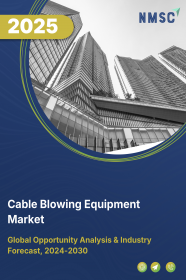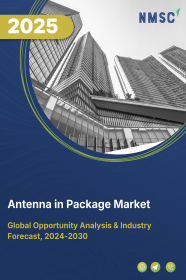
Cable Blowing Equipment Market by Power Type (Hydraulic Powered, Pneumatically Powered, Electric, and Drill Driven), by Cable Type (Microduct and Normal Cable), by Tube Diameter (3–16 mm, 7–12 mm, and 12–63 mm), and by End-User (Commercial, Defense, Telecom Operators, Utility, Construction Firms, Government & Municipalities, and Others) – Global Opportunity Analysis and Industry Forecast, 2025–2030
US Tariff Impact on Cable Blowing Equipment Market
Trump Tariffs Are Reshaping Global Business
Cable Blowing Equipment Industry Overview
The global Cable Blowing Equipment Market size was valued at USD 114.1 million in 2024 and is predicted to reach USD 119.8 million by the end of 2025. The industry is predicted to reach USD 152.8 million by 2030 with a CAGR of 5% from 2025 to 2030.
The global market is experiencing significant growth driven by several factors, with fiber optic expansion leading the way. Government-backed initiatives, such as FTTH projects in India and the U.S. BEAD Program, are pushing the demand for efficient fiber-optic installation tools. Additionally, the growing focus on smart city developments, IoT integration, and rural connectivity projects further propels the adoption of Fiber optic cable installation.
Innovations in equipment design, focusing on lightweight, scalable, and eco-friendly solutions, are helping companies address the demand for cost-effective, sustainable, and high-performance deployment tools. However, the high operational and equipment costs remain a barrier for smaller contractors and ISPs, though the trend toward sustainability offers a promising opportunity for market growth.
Fiber Optic Expansion Boosts the Cable Blowing Equipment Market Demand
The global rollout of fiber networks is a major driver for cable blowing equipment market growth. With government-backed FTTH initiatives gaining momentum, such as India’s BharatNet and the U.S. Broadband Equity Access and Deployment (BEAD) Program, demand for fiber-optic cable installation tools has surged. Companies like Fremco and Plumettaz have responded by introducing compact, field-adaptable solutions designed for varied terrains and climates, aligning with the market’s shift toward modular and scalable deployment.
Smart Cities and Infrastructure Digitization Fuel Market Growth
The integration of IoT, 5G, and data-intensive technologies into urban infrastructure has elevated the need for fast, efficient cabling. Telecommunications infrastructure enables streamlined, non-invasive fiber optic installations, especially in retrofitting scenarios. Smart cities across Europe and Asia are prioritizing digital transformation, boosting the market size for advanced cable jetting tools. Stanlay’s recent launch of the CBM-G1 in 2023, a precision-controlled cable blowing unit, is tailored for smart infrastructure projects requiring high-accuracy fiber laying.
Rural Connectivity Initiatives Drives the Market Growth for Cable Blowing Equipment
As governments focus on bridging the digital divide, rural broadband rollout projects are driving purchases of durable and easy-to-use blowing machines. Lightweight equipment with improved reach and lower maintenance needs is gaining preference. The 2023 launch by Zeitler of its new MicroJet Compact series targets remote area deployment, offering robust performance even in less-than-ideal environments.
High Equipment and Operational Costs Hinders the Market Growth
Cable blowing equipment, especially models designed for microduct-compatible installations and multi-diameter cables, involves significant upfront and maintenance costs. For smaller contractors and ISPs, the high price of advanced machines from brands like Plumettaz and Fremco can be a barrier, limiting adoption in cost-sensitive regions. This cost sensitivity can slow market penetration and adoption, particularly in areas with budget constraints.
Sustainability-Centric Deployments Create Opportunity for Market Growth
The global shift toward sustainable infrastructure is significantly influencing the cable industry. As telecom providers and utility companies move toward greener operations, there is a rising demand for energy-efficient and environmentally responsible equipment. Cable blowing systems that minimize air and lubricant consumption, reduce operational emissions, and incorporate recyclable or biodegradable materials are becoming increasingly preferred.
In 2024, Plumettaz introduced its PFT-HDD Eco+ model, a hybrid cable blowing machine designed for low energy usage and optimized air flow efficiency, significantly cutting down carbon emissions during fiber deployment. Such innovation aligns with international environmental targets and growing ESG (environmental, social, and governance) benchmarks, creating a compelling opportunity for market growth.
Market Segmentations and Scope of the Study
The cable blowing equipment market report is segmented on the basis of power type, cable type, tube diameter, end-users, and region. On the basis of power type, the market is divided into hydraulic-powered, pneumatically powered, electric, and drill driven. On the basis of cable type, the market is classified into microduct and normal cable. On the basis of tube diameter, the market is segmented into 3–16 mm, 7–12 mm, and 12–63 mm. On the basis of end-users, the market is segmented into commercial, defense, telecom operators, utility, construction firms, government & municipalities, and others. Regional breakdown and analysis of each of the aforesaid segments include regions comprising North America, Europe, Asia-Pacific, and Rest of the World (RoW).
Geographical Analysis
In North America, particularly in the U.S. and Canada, the cable blowing equipment market share continues to benefit from expansive broadband and 5G deployments. Government-funded initiatives like the Broadband Equity, Access, and Deployment (BEAD) Program have bolstered fiber rollouts, especially in underserved and rural areas. Companies such as General Machine Products (GMP), now under Klein Tools, have expanded their market presence with product innovation and supply chain consolidation.
Notably, in 2023, GMP launched a high-capacity fiber blowing machine designed for microduct systems, supporting both long-distance and urban installations. The emphasis on dense fiber networks and urban micro trenching is expected to boost regional market share and growth potential significantly.
Europe's market share is strongly influenced by its push for digital and environmental transformation. Countries like Germany, France, and the UK are accelerating fiber-to-the-home (FTTH) deployments under the EU’s Digital Decade strategy.
Sustainability remains central, with operators actively seeking low-emission and recyclable solutions. Companies such as Plumettaz continue to lead with energy-efficient jetting systems. In 2024, Plumettaz introduced the PJM Whisper Jet, a compact and quiet machine engineered for urban fiber installation projects with a reduced carbon footprint. Meanwhile, Zeitler AG rolled out the ZEITLER JetMaxX+ in early 2025, a high-efficiency, eco-conscious cable blower optimized for high-speed installations. These developments reinforce the region’s focus on eco-smart infrastructure.
Asia-Pacific is witnessing exponential growth in the market, supported by large-scale fiber rollout programs in countries like China, India, and South Korea. The Indian government's BharatNet Phase III and China’s ongoing 5G fiber backhaul expansion are key market drivers. Regional players such as Adishwar and Stanlay are tailoring solutions for rugged terrain and cost-sensitive deployment.
In 2023, Stanlay introduced its CBM Pro Fiber Blower, capable of handling both micro and traditional ducts, addressing the diverse installation needs across the subcontinent. Adishwar followed in 2024 with a modular, lubricant-free cable jetting system that minimizes maintenance, appealing to sustainability-conscious buyers. These launches reflect the region's growing demand for efficient and scalable infrastructure solutions.
The Rest of the World, which includes Latin America, the Middle East, and Africa, is emerging as a significant contributor to the industry size. Driven by smart city initiatives and digital connectivity goals, countries like Brazil, South Africa, and the UAE are ramping up fiber deployments. In this landscape, global brands are collaborating with local integrators to offer adaptable solutions.
For example, Fremco, launched its Fremco PowerFlow Mini in 2023, engineered for narrow ducts and shorter installations, ideal for the urban infrastructure common in the Middle East. Meanwhile, Turkish manufacturer UPCOM introduced an upgraded air-control system for its cable blowing machines in 2025, enhancing energy efficiency and ease of use. These innovations are helping meet the region’s diverse technical and environmental demands, creating fresh market opportunities.
Strategic Moves Shaping the Industry
Key players in the global cable blowing equipment industry are strategically advancing through innovation, geographic expansion, and sustainability-led manufacturing to strengthen their market share and enhance long-term competitiveness. Companies such as Plumettaz, Fremco, Zeitler, Stanlay, and General Machine Products (GMP) have invested in energy-efficient and digitally controlled cable jetting systems that cater to both high-density urban networks and long-haul installations.
For instance, Plumettaz launched its PJM Whisper Jet in 2024, a low-noise, carbon-reduced jetting system designed for urban deployments. Similarly, Zeitler AG introduced the JetMaxX+ in 2025, integrating precision control features and lower air consumption, aligning with rising environmental compliance standards across Europe and North America.
Despite these technological strides, manufacturers face persistent challenges such as fluctuating raw material costs, supply chain disruptions, and skilled labor shortages, particularly in developing regions. Moreover, the rapid evolution of fiber optic cable designs and installation protocols necessitates continual adaptation of product offerings. To overcome these hurdles, leading firms are forming strategic partnerships with telecom operators and infrastructure firms, allowing co-development of machines tailored to real-time field requirements.
Looking ahead, opportunities remain strong, especially in sustainable infrastructure development and smart city initiatives globally. With governments emphasizing low-impact installation technologies, firms offering lubricant-free systems, biodegradable components, and integrated monitoring features are positioned to lead the next wave of industry growth.
Key Benefits
-
The report provides quantitative analysis and estimations of the market from 2025 to 2030, which assists in identifying the prevailing market opportunities.
-
The study comprises a deep dive analysis of the current and future cable blowing equipment market trends to depict prevalent investment pockets in the market.
-
Information related to key drivers, restraints, and opportunities and their impact on the market is provided in the report.
-
Competitive analysis of the players, along with their market share, is provided in the report.
-
SWOT analysis and Porters Five Forces model is elaborated in the study.
-
Value chain analysis in the Market study provides a clear picture of roles of stakeholders.
Cable Blowing Equipment Market Key Segments
By Power Type
-
Hydraulic Powered
-
Pneumatically Powered
-
Electric
-
Drill Driven
By Cable Type
-
Microduct
-
Normal Cable
By Tube Diameter
-
3 - 16 mm
-
7 - 12 mm
-
12 - 63 mm
By End User
-
Commercial
-
Defense
-
Telecom operators
-
Utility
-
Construction firms
-
Government & municipalities
-
Others
By Region
-
North America
-
The U.S.
-
Canada
-
Mexico
-
-
Europe
-
The UK
-
Germany
-
France
-
Italy
-
Spain
-
Denmark
-
Netherlands
-
Finland
-
Sweden
-
Norway
-
Russia
-
Rest of Europe
-
-
Asia Pacific
-
China
-
Japan
-
India
-
South Korea
-
Australia
-
Indonesia
-
Singapore
-
Taiwan
-
Thailand
-
Rest of Asia Pacific
-
-
RoW
-
Latin America
-
Middle East
-
Africa
-
Key Players
-
Stanlay
-
Allame Makina Fiber Optic Cable Blowing Machines
-
Upcom Telekomunikasyon
-
Fremco A/S
-
Condux International
-
Adishwar Tele-Networks
-
Altec
-
Jetting AB
-
Katimex Cielker GmbH
-
Plumettaz S.A.
-
CBS Product
-
Jakob Thaler GMBH
-
Lancier Cable GmbH
-
Hexatronic Group
-
Anfkom Telecom
REPORT SCOPE AND SEGMENTATION
|
Parameters |
Details |
|
Market Size in 2024 |
USD 114.1 Million |
|
Revenue Forecast in 2030 |
USD 152.8 Million |
|
Growth Rate |
CAGR of 5.0% from 2025 to 2030 |
|
Analysis Period |
2024–2030 |
|
Base Year Considered |
2024 |
|
Forecast Period |
2025–2030 |
|
Market Size Estimation |
Million (USD) |
|
Growth Factors |
|
|
Countries Covered |
28 |
|
Companies Profiled |
15 |
|
Market Share |
Available for 10 companies |
|
Customization Scope |
Free customization (equivalent up to 80 working hours of analysts) after purchase. Addition or alteration to country, regional, and segment scope. |
|
Pricing and Purchase Options |
Avail customized purchase options to meet your exact research needs. |

















 Speak to Our Analyst
Speak to Our Analyst




















